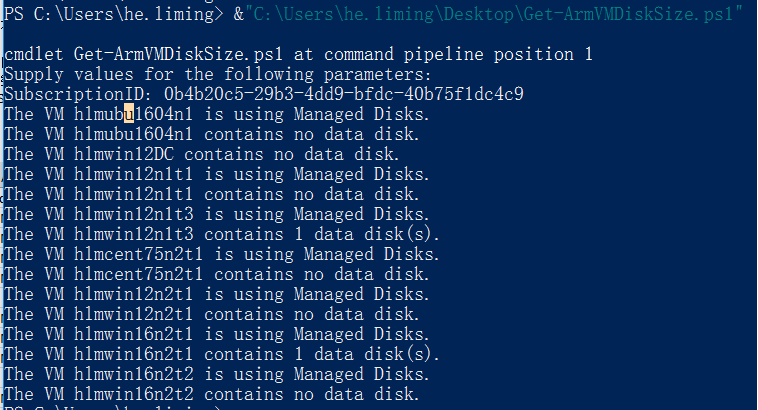脚本内容:
<# .SYNOPSIS This script grab all ARM VM VHD file in the subscription and caculate VHD size. .DESCRIPTION This script grab all ARM VM VHD file in the subscription and caculate VHD size. .Example .\Get-ArmVMDiskSize.ps1 -subscriptionid xxxxxxx-xxxx-xxxx-xxxxxxx Then input the username and password of Azure China. .Disclaimer This sample code is provided for the purpose of illustration only and is not intended to be used in a production environment. THIS SAMPLE CODE AND ANY RELATED INFORMATION ARE PROVIDED "AS IS" WITHOUT WARRANTY OF ANY KIND, EITHER EXPRESSED OR IMPLIED, INCLUDING BUT NOT LIMITED TO THE IMPLIED WARRANTIES OF MERCHANTABILITY AND/OR FITNESS FOR A PARTICULAR PURPOSE. We grant You a nonexclusive, royalty-free right to use and modify the Sample Code and to reproduce and distribute the object code form of the Sample Code, provided that You agree: (i) to not use Our name, logo, or trademarks to market Your software product in which the Sample Code is embedded; (ii) to include a valid copyright notice on Your software product in which the Sample Code is embedded; (iii) to indemnify, hold harmless, and defend Us and Our suppliers from and against any claims or lawsuits, including attorneys’ fees, that arise or result from the use or distribution of the Sample Code. #> param( [Parameter(Mandatory = $true)] [String]$SubscriptionID ) function Get-BlobBytes { param ( [Parameter(Mandatory=$true)] [Microsoft.WindowsAzure.Commands.Common.Storage.ResourceModel.AzureStorageBlob]$Blob) # Base + blob name $blobSizeInBytes = 124 + $Blob.Name.Length * 2 # Get size of metadata $metadataEnumerator = $Blob.ICloudBlob.Metadata.GetEnumerator() while ($metadataEnumerator.MoveNext()) { $blobSizeInBytes += 3 + $metadataEnumerator.Current.Key.Length + $metadataEnumerator.Current.Value.Length } if ($Blob.BlobType -eq [Microsoft.WindowsAzure.Storage.Blob.BlobType]::BlockBlob) { $blobSizeInBytes += 8 $Blob.ICloudBlob.DownloadBlockList() | ForEach-Object { $blobSizeInBytes += $_.Length + $_.Name.Length } } else { [int64]$rangeSize = 1GB [int64]$start = 0; $pages = "Start"; While ($pages) { try { $pages = $Blob.ICloudBlob.GetPageRanges($start, $rangeSize) } catch { if ($_ -like "*the range specified is invalid*") { $pages = $null break } else { write-error $_ } } $pages | ForEach-Object { $blobSizeInBytes += 12 + $_.EndOffset - $_.StartOffset } $start += $rangeSize } } return @{"vhdlength" = "{0:F2}" -f ($blob.Length / 1GB) -replace ","; "usedsize" = "{0:F2}" -f ($blobSizeInBytes / 1GB) -replace ","} } function Get-VMCoresandMemory { param ( [Parameter(Mandatory=$true)] [String]$VMSize) $csvfile = $env:USERPROFILE+"\Downloads\VMsizes.csv" $VMSizeList = Import-Csv $csvfile $VMcoresmem = $VMSizeList | where {$_.Size -eq $VMSize} return @{"Cores" = $VMcoresmem.Cores; "Memory" = $vmcoresmem.Memory} } <# Import-Module AzureRM.Compute $PSversion = (Get-Module -Name AzureRM.Compute).Version If($PSversion -lt [System.Version]"2.6.0") { Write-Host "PowerShell Version too low. Visit https://docs.microsoft.com/en-us/powershell/azure/overview to install the newest AzureRM module."; Exit } #> Login-AzureRmAccount -EnvironmentName AzureChinaCloud | Out-Null Get-AzureRmSubscription -SubscriptionId $SubscriptionID | Out-Null Select-AzureRmSubscription -SubscriptionId $SubscriptionID | Out-Null $armfile = $env:USERPROFILE+"\Downloads\armvms-"+$subscriptionID+".csv" Set-Content $armfile -Value "ResourceGroup,VMName,VMSize,Cores,Memory(GB),DiskName,OSorData,VHDUri,StorageAccount,VHDLength,VHDUsedSize" Write-Verbose "ARM part starts!" $armvms = Get-AzureRmVM foreach($armvm in $armvms) { $vmresourcegroup = $armvm.ResourceGroupName $vmname = $armvm.Name $vmsize = $armvm.HardwareProfile.VmSize $vmcores = (Get-VMCoresandMemory -VMSize $vmsize).Cores $vmmemory = (Get-VMCoresandMemory -VMSize $vmsize).Memory $vmosdiskname = $armvm.StorageProfile.OsDisk.Name If ($armvm.StorageProfile.OsDisk.vhd -eq $null) { Write-Host ("The VM "+$vmname+" is using Managed Disks.") $vmosdisksize = (Get-AzureRmDisk -ResourceGroupName $vmresourcegroup -DiskName $vmosdiskname).DiskSizeGB Add-Content $armfile -Value ($vmresourcegroup+","+$vmname+","+$vmsize+“,”+$vmcores+","+$vmmemory+","+$vmosdiskname+",OSDisk,No visible VHD files for Managed Disk VM,No visible storage account for Managed Disk VM,"+$vmosdisksize+",Managed Disks don't support GetBlobSize method") $datadisks = $armvm.StorageProfile.DataDisks If ($datadisks.Count -eq 0) { Write-Host ("The VM "+$vmname+" contains no data disk.") } else { Write-Host ("The VM "+$vmname+" contains "+$datadisks.Count+" data disk(s).") foreach ($datadisk in $datadisks) { $vmdatadiskname = $datadisk.Name $vmdatadisksize = (Get-AzureRmDisk -ResourceGroupName $vmresourcegroup -DiskName $vmdatadiskname).DiskSizeGB Add-Content $armfile -Value (",,,,,"+$vmdatadiskname+",DataDisk,No visible VHD files for Managed Disk VM,No visible storage account for Managed Disk VM,"+$vmdatadisksize+",Managed Disks don't support GetBlobSize method") } } } else { $vmosdiskuri = $armvm.StorageProfile.OsDisk.Vhd.Uri $vmosdiskstorageaccountname = ($armvm.StorageProfile.OsDisk.Vhd.Uri.Split("{/,.}"))[2] $vmosdiskstorageaccountkey = (Get-AzureRmStorageAccount | ? {$_.StorageAccountName -eq $vmosdiskstorageaccountname} | Get-AzureRmStorageAccountKey)[0].Value $vmosdiskstorageaccountcontext = New-AzureStorageContext -StorageAccountName $vmosdiskstorageaccountname -StorageAccountKey $vmosdiskstorageaccountkey $vmosdiskcontainername = ($armvm.StorageProfile.OsDisk.Vhd.Uri.Split("/")[3]) $vmosdiskblobname = ($armvm.StorageProfile.OsDisk.Vhd.Uri.Split("/")[(($armvm.StorageProfile.OsDisk.Vhd.Uri.Split("/")).count) - 1]) $vmosdiskblob = Get-AzureStorageBlob -Context $vmosdiskstorageaccountcontext -blob $vmosdiskblobname -Container $vmosdiskcontainername $osvhdsize = Get-BlobBytes $vmosdiskblob If ($vmsize -like "*DS*") { Add-Content $armfile -Value ($vmresourcegroup+","+$vmname+","+$vmsize+","+$vmcores+","+$vmmemory+","+$vmosdiskname+",OSDisk,"+$vmosdiskuri+","+$vmosdiskstorageaccountname+","+$osvhdsize+",Premium Disks don't support GetBlobSize method") } else { Add-Content $armfile -Value ($vmresourcegroup+","+$vmname+","+$vmsize+","+$vmcores+","+$vmmemory+","+$vmosdiskname+",OSDisk,"+$vmosdiskuri+","+$vmosdiskstorageaccountname+","+$osvhdsize.vhdlength+","+$osvhdsize.usedsize) } $datadisks = $armvm.StorageProfile.DataDisks If ($datadisks.count -eq 0) { Write-Host ("The VM "+$vmname+" contains no data disk.") } else { Write-Host ("The VM "+$vmname+" contains "+$datadisks.Count+" data disk(s).") foreach ($datadisk in $datadisks) { $vmdatadiskname = $datadisk.Name $vmdatadiskuri = $datadisk.Vhd.Uri $vmdatadiskstorageaccountname = ($vmdatadiskuri.Split("{/,.}"))[2] $vmdatadiskstorageaccountkey = (Get-AzureRmStorageAccount | ? {$_.StorageAccountName -eq $vmdatadiskstorageaccountname} | Get-AzureRmStorageAccountKey)[0].Value $vmdatadiskstorageaccountcontext = New-AzureStorageContext -StorageAccountName $vmdatadiskstorageaccountname -StorageAccountKey $vmdatadiskstorageaccountkey $vmdatadiskcontainername = ($datadisk.Vhd.Uri.Split("/")[3]) $vmdatadiskblobname = ($datadisk.Vhd.Uri.Split("/")[(($datadisk.Vhd.Uri.Split("/")).count) - 1]) $vmdatadiskblob = Get-AzureStorageBlob -Context $vmdatadiskstorageaccountcontext -blob $vmdatadiskblobname -Container $vmdatadiskcontainername $datavhdsize = Get-BlobBytes $vmdatadiskblob If ($vmsize -like "*DS*") { Add-Content $armfile -Value (",,,,,"+$vmdatadiskname+",DataDisk,"+$vmdatadiskuri+","+$vmdatadiskstorageaccountname+","+$datavhdsize.vhdlength+",Premium Disks don't support GetBlobSize method") } else { Add-Content $armfile -Value (",,,,,"+$vmdatadiskname+",DataDisk,"+$vmdatadiskuri+","+$vmdatadiskstorageaccountname+","+$datavhdsize.vhdlength+","+$datavhdsize.usedsize) } } } } } Write-Verbose "ARM part finished!"
脚本运行步骤:
1.安装较新的Azure Powershell模块,https://docs.azure.cn/zh-cn/powershell-install-configure
2.将附件压缩包下的.csv文件拷贝至机器%UserProfile%\Downloads 文件夹下
3.在PowerShell中运行脚本,提供订阅号并登陆账号,即可成功抓取虚拟机的CPU核数、内存大小及磁盘信息
执行脚本及输出示例:


I hear and I forget. I see and I remeber. I do and I understand!




